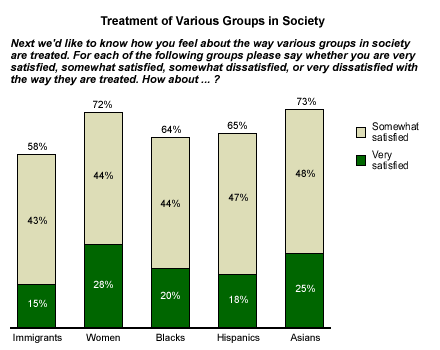Every year, Gallup asks Americans about the treatment of women and minorities in U.S. society, to get a sense of whether the public believes conditions are improving for these groups, many of which have faced discrimination in the past. This topic underlies many hot social and economic questions: Will it be tougher or easier to argue on behalf of affirmative action programs in the future? Does the fact that white males occupy more than 90% of senior management positions at Fortune 1,000 companies create a disconnect between corporate America and the country's consumer base? Will the fact that many more women than men are graduating from college influence standards for the treatment of women? The list of questions could go on.
The basic results for the five groups Gallup asked about in the June 2003 survey* -- immigrants, women, blacks, Hispanics, and Asians -- show that women and Asians come out on top (as they have in past Minority Relations polls), with more than 7 in 10 Americans expressing satisfaction with the way people in these two groups are treated.

Insiders vs. Outsiders
There remain troubling differences in perceptions of the way the various groups are treated. One way to examine social fault lines is by looking at the degree to which perceptions of "insiders" -- members of each of the groups asked about -- differ from those who do not have direct experience as group members.
There is a relatively small gap between genders in their ratings of how women are treated in society: men and women aren't extremely likely to view this issue differently. But when it comes to the treatment of racial and ethnic minorities, sharp distinctions emerge. For example, two-thirds of nonblacks say they are satisfied with the way blacks are treated, but only 40% of blacks say they are satisfied with the way blacks are treated (59% of blacks are dissatisfied). To a lesser degree, a gap exists in perceptions of Hispanic treatment according to ethnicity. Two-thirds of non-Hispanics are satisfied with the way Hispanics are treated, while about half (51%) of Hispanics agree.

Blacks are also less likely that whites to express satisfaction with the way Hispanics are treated, and their views are very similar to those of Hispanics on this issue (53% satisfaction among blacks and 51% among Hispanics). And while Hispanics are somewhat more pessimistic than the general population about the way blacks are treated (58% are satisfied), their expressed level of satisfaction about black treatment is closer to that of whites (68%) than blacks (40%).
Satisfaction with the treatment of immigrants is lowest among the groups tested. This is largely results from the opinions of women and minorities, who may be more sympathetic to the plight of disadvantaged groups: 62% of men say they are very or somewhat satisfied with the treatment of immigrants, as do 53% of women. Sixty-three percent of whites are satisfied with the way immigrants are treated, compared to 42% of Hispanics, who make up the largest sector of American immigrants, and 44% of blacks are satisfied.
Bottom Line
The data for this survey were gathered just prior to landmark Supreme Court decisions on affirmative action and homosexual rights, which altered the landscape of social justice. Those decisions may reflect ongoing public sentiment that when it comes to fairness, American society still leaves much to be desired.
Poll data indicate that perceptions regarding the treatment of blacks in particular are capable of creating rifts. Furthermore, blacks are sensitive not only to mistreatment of their own racial group, but to other groups as well. In the 20th century, the civil rights struggle was largely focused on the plight of black Americans; despite all the gains, these data suggest that struggle continues early in the 21st.
*Results are based on telephone interviews with 1,385 national adults, aged 18 and older, conducted June 12-18, 2003, including oversamples of blacks and Hispanics that are weighted to reflect their proportions in the general population. For results based on the total sample of national adults, one can say with 95% confidence that the maximum margin of sampling error is ±3%.
Results for the sample of 668 men, aged 18 and older, are based on telephone interviews conducted June 12-18, 2003. For results based on the total sample, one can say with 95% confidence that the margin of sampling error is ±4%. [Results for Q.1-10 based on June 12-15 sample of 489 men; the maximum margin of sampling error is ±5%.]
Results for the sample of 717 women, aged 18 and older, are based on telephone interviews conducted June 12-18, 2003. For results based on the total sample, one can say with 95% confidence that the margin of sampling error is ±4%. [Results for Q.1-10 based on June 12-15 sample of 517 women; the maximum margin of sampling error is ±5%.]
Results for the sample of 821 non-Hispanic whites, aged 18 and older, are based on telephone interviews conducted June 12-15, 2003. For results based on the total sample, one can say with 95% confidence that the margin of sampling error is ±4%.
Results for the sample of 241 blacks, aged 18 and older, are based on telephone interviews conducted June 12-18, 2003. For results based on the total sample, one can say with 95% confidence that the margin of sampling error is ±7%.
Results for the sample of 266 Hispanics (including 12 Hispanic respondents who identify their race as black), aged 18 and older, conducted June 12-18, 2003. For results based on the total sample, one can say with 95% confidence that the margin of sampling error is ±7%. (53 out of the 266 interviews with Hispanics were conducted in Spanish).
In addition to sampling error, question wording and practical difficulties in conducting surveys can introduce error or bias into the findings of public opinion polls.
